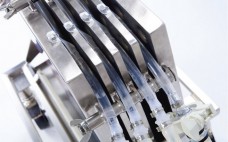Downstream protein purification (the stage in which a protein is isolated and purified) is one of the last steps in biotherapeutic manufacturing. Single-use technologies are an increasingly popular choice for both upstream and downstream bioprocessing because they offer significant benefits over traditional multiuse manufacturing systems. Single-use technologies also provide an array of logistical benefits, including reduced costs, minimized risk of cross-contamination, and improved operational efficiency (1). Challenges remain, however, in designing a complete, streamlined, single-use process for downstream protein purification.…
Separation/Purification
Nucleic Acid Impurity Reduction in Viral Vaccine Manufacturing
Commercial-scale viral vaccine manufacturing requires production of large quantities of virus as an antigenic source. To deliver those quantities, a number of systems are used for viral replication based on mammalian, avian, or insect cells. To overcome the inherent limitations in production outputs with serial propagation of cells, mammalian cells can be immortalized, which increases the number of times they can divide in culture. Modifications that immortalize cells are typically accomplished through mechanisms similar to those converting normal cells to…
Analysis By Size and Charge
An early BPI Lab article addressed the power of liquid chromatographic separations for biopharmaceutical laboratory use (1). Such techniques separate biomolecules based on a number of different properties: size, solubility, hydrophobicity/-philicity, binding affinity. The next most powerful means of separation — and thus high-resolution identification — of nucleic acids and proteins/peptides is based primarily on electrostatic properties: electrophoresis. Although it doesn’t really work in a process or preparative setting, it is a fundamental technique in modern biopharmaceutical laboratories, where it…
Accounting for the Donnan Effect in Diafiltration Optimization for High-Concentration UFDF Applications
The biopharmaceutical industry is targeting high-concentration protein formulations to enable subcutaneous administrations. Such administration can provide better patient convenience than intravenous administration. One challenge associated with high-concentration formulations is increased electrostatic interaction between proteins and excipients. That is a result of increased protein-charge density at high protein concentrations. Such interactions can create an offset between excipient levels in final products and diafiltration buffers in ultrafiltration processes. The effect of such electrostatic interactions in a membrane process is known as the…
Effects of Pressure Sensor Calibration Offset on Filter Integrity Test Values
Food and Drug Administration (FDA) and European good manufacturing practices (GMPs) require integrity testing of sterilizing-grade filters for producing injectables and other biologics. The diffusion test (also called the forward-flow test) and bubble-point test (also called the disk test) of a sterilizing-grade filter are both filter-integrity tests. The accuracy of both relies on calibration of a pressure sensor in the respective integrity test unit. Calibration of the pressure sensor of a filter-integrity testing device is an essential part of quality…
Industry Adoption of Membrane Adsorbers
Membrane adsorbers (MAs) are the fastest-growing segment in single-use bioprocessing. But their future is not entirely certain. According to BioPlan Associates’ latest survey of biopharmaceutical manufacturing, the MA market has been growing at ~20% annually since 2006 (1). Paradoxically, however, the segment may not be a true “rising star.” Our study also shows that MAs remain among the least-often adopted devices among biomanufacturers. So the question of how and whether MA technology can revolutionize bioprocessing remains open. Market for Membrane…
Simpler and More Efficient Viral Vaccine Manufacturing
Human and veterinary vaccines are divided into five main categories: conjugate, toxoid, subunit, inactivated (killed), and live (attenuated) vaccines (1). The vast majority of currently licensed human and veterinary vaccines are inactivated or live (2, 3). They are produced mostly using adherent cells: primary cells such as chicken embryo fibroblasts (CEF), human diploid cells such as MRC-5, or continuous cell lines such as Vero and MDCK (4). The pioneering legacy inherited by vaccine manufacturing development has led to strategies for…
Emerging Challenges to Protein A
Protein A affinity chromatography has been a target for replacement since its commercial debut, mainly because of its high acquisition cost. The technique became established despite the cost because it was born into an industrial culture that favored speed to market over manufacturing economy (1). Vendors have since strengthened protein A’s position with incremental but worthy improvements such as higher capacity, lower ligand leaching, and modest tolerance of NaOH. Collateral improvements in polishing technologies, such as the high throughput and…
Protein A
The number of blockbuster monoclonal antibody (MAb) drugs continues to grow. In 2008, MAbs generated revenues in excess of US$15 billion (1), making them the highest-earning category of all biotherapeutics. The world MAb market will reach $62.3 billion in 2015, with next-generation therapeutic antibody revenues reaching $2.3 billion in 2015 according to Visiongain reports published in September and November 2011 (2, 3). Biosimilar antibodies will also begin to enter established markets as regulatory authorities clear approval pathways for them. Most…
Increasing Purity and Yield in Biosimilar Production
Current downstream processing strategies for recombinant proteins often require multiple chromatographic steps, which may lead to poor overall yields. Product purification can be especially difficult when a target protein displays reduced stability, forms isoforms or misprocessed variants, or needs to be purified from a complex mixture containing a high degree of contaminants. One technology that has been developed to tackle such limitations is based on custom-made chromatography matrices containing camelid-based single-domain antibody fragments. With a molecular weight of only 12–15…

